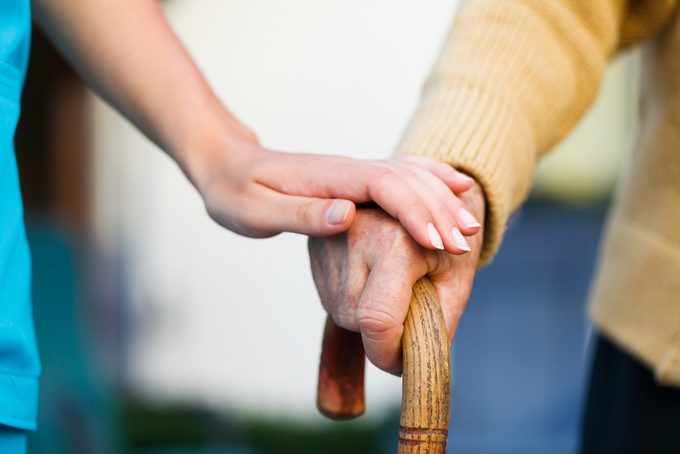Why are Women at Greater Risk for Alzheimer’s Disease?
Women are most likely to get Alzheimer’s – of the estimated 747,000 Canadians living with the disease, about 70 percent are women. Shockingly but not surprisingly, little research has focused on the impact of gender – until now.

Dr. Pauline Maki has been studying how women’s brains change as they age since her doctorate decades ago. Still, when she recently started noticing changes in her own cognitive function, she was a little freaked out.
“I had to ask my father to tell me the last name of the Ben who starred with Matt Damon,” she says. “He said, ‘Ben Affleck?’ And I said, ‘Yes, that’s right, Ben Affleck.’ If you gave me that as a multiple-choice question, I would’ve picked his name out, no problem. It’s very frustrating.”
Dr. Maki, a professor of psychiatry and psychology and director of women’s mental health research at the University of Illinois at Chicago, had to remind herself that issues with memory retrieval are normal for women in their 40s and 50s – and they’re temporary. The problem, she says, is that a lot of women don’t know that. In fact, most of us don’t know much at all about the differences between normal blips in brain function and signs of dementia or what it means to be diagnosed with Alzheimer’s disease, especially for women.
“The biggest problem we face is that researchers aren’t looking at biological sex differences in brain changes, period,” says Dr. Mary Tierney, a professor and clinician scientist in the department of family and community medicine at the University of Toronto and an affiliate scientist at Sunnybrook Health Sciences Centre in Toronto. Yet, of the estimated 747,000 Canadians living with Alzheimer’s, about 70 percent are women.
“There’s a difference between prevalence and incidence,” says Dr. Tierney. “There is a higher prevalence of Alzheimer’s disease in women which can be explained by the fact that women live longer and age is the most important risk factor. There’s also a higher incidence in women, so of those who develop Alzheimer’s after age 80, more of them are women.”
Last July, research from the Duke Institute for Brain Sciences in North Carolina showed that women with mild cognitive impairment also decline twice as fast as men with the same condition, but we don’t know why. “Studies tend to lump all Alzheimer’s patients together without comparing sex differences,” says Dr. Tierney. “Even studies with rodents often use male rats and mice – the argument is that it’s easier and cheaper to have one sex and, gosh, those female rodents complicate things by going into estrus [the time in the reproductive cycle that causes them to be in heat]. But if you’re only studying males, whether in mouse or human studies, you’re doing incomplete, bad research. You’re only telling half of the story.”
Our aging brains
Dementia isn’t a disease in itself nor is it a normal part of aging. It’s actually an umbrella term for a set of symptoms that affects the brain, which includes memory loss, impaired judgment and changes in mood and behaviour. If you have two or more of these symptoms and they’re severe enough to make it difficult for you to function day to day, you should consult a doctor who’s qualified to make an assessment or refer you to a specialist to determine whether that’s dementia. If so, Alzheimer’s disease is the most common cause.
“One of the biggest misconceptions is that memory is the main indicator of dementia,” says Dr. Larry Chambers, a scientific adviser for the Alzheimer Society of Canada. “But it’s actually not as important as being able to function and make decisions about finances, driving and the workplace.”
People often don’t realize that dementia is progressive, says Dr. Chambers, or that the rate of progression varies widely. “Unfortunately, as soon as people are diagnosed with dementia, they’re written off,” he says. “But dementia doesn’t happen overnight; it is gradual and can take years. A lot of the time, people can continue to lead happy and productive lives. What we need to do is to focus on better social care and create a more understanding and supportive environment.”
Dr. Chambers says that the general lack of knowledge about dementia has created a troubling stigma. It shows up in language (the word senile, considered a derogatory term, is still bandied about), as well as in a broader social context, such as the lack of training and funding for long-term-care homes. In Ontario alone, there are about 630 long-term-care residences. Of the 75,000 people who live in them, probably 50,000 have dementia, he says. “The present food allowance in long-term-care homes in Ontario is smaller than the food allowance in prisons,” he says. “That speaks volumes, doesn’t it?”
Three out of four Canadians know someone with dementia. Although the biggest risk factor is age (after you hit 65, your risk doubles every five years), people in their 30s, 40s and 50s can develop dementia. Biological onset in an individual can start up to 25 years before the symptoms of dementia show up. This, says Dr. Chambers, is why educating people about dementia early is essential. “As a society, we need to help young people understand dementia,” he says. “Long-term-care homes need to be better integrated into the community, and there should be more mental health education in schools.”
Dr. Chambers is pushing for a national dementia strategy that would not only lead to more research but also help raise awareness about social issues. The most pressing is how we care for people with dementia, a burden that typically falls on women, who account for 70 percent of family caregivers. While Dr. Chambers doesn’t see much significance in the biological sex differences between men and women facing cognitive decline, he does agree that there are important differences when it comes to gender roles. “Alzheimer’s is like other chronic diseases,” he says. “Cancer of the lungs is cancer of the lungs, whether you’re a man or a woman. There’s a list of 10 signs of dementia, and it’s not one list for men and one for women; it’s
the same list. But the societal issues facing women compared to men are very significant.”
How much does sex matter?
Dr. Maki says the claims that women’s and men’s brains aren’t different and don’t age differently is untenable. “Sometimes I think resistance to the idea is due to a fear that knowledge could be used to discriminate against one sex over the other and that it could be detrimental to women,” she says. “But, in fact, the opposite is true. Unless you can identify the unique brain health needs of women, how can you help them preserve their cognitive function?”
There is plenty of evidence to support the claim that men’s and women’s brains are different and that we use our brains differently, she says. Neuroimaging has become sophisticated enough that we can map out different regions of the brain to see how they communicate with each other. “These maps have revealed that connectivity in the brain is fundamentally different in men and women,” says Dr. Maki. “Women show greater functional connectivity between the two hemispheres, while men show greater connectivity within hemispheres.”
We also know that the fact that women go through menopause has an impact on how their brains age, she adds. Studies show that women’s brains begin to change in perimenopause, when their cycles become less regular. “That’s when processing speed and memory function change, and our best hypothesis is that it’s due to changes in estrogen,” she says. The good news is that a woman’s cognitive function appears to recover one to five years after her final period. “One possibility is that the brain adjusts, probably by producing its own estrogen to compensate,” she adds. “Unfortunately, there are no large-scale trials of estrogen in perimenopause, but there is a lot of data to suggest that estrogen is cognitively protective.”
Older men actually have more estradiol (the active component of estrogen) in their brains than post-menopausal women do, says Dr. Tierney. In January, researchers at the Norwegian University of Science and Technology found that women who take estrogen supplements around the start of menopause are able to preserve their brain structure, potentially reducing their risk of dementia.
There are many estrogen receptor sites in the brain, especially in the areas responsible for memory and learning. But as estrogen becomes depleted, those receptor sites die, which may have a significant impact on cognitive function. “We did a study that showed that giving hormone replacement therapy to post-menopausal women over a two-year period allowed them to maintain the same cognitive performance, whereas women who didn’t receive the therapy showed a decline,” says Dr. Tierney. “It’s definitely an area that needs more research.”
Taking control
The best news about Alzheimer’s is that there are a lot of things you can do to reduce your risk. “There’s much more hope around preventing Alzheimer’s disease than people realize,” says Dr. Maki. It’s estimated that up to half of cases of Alzheimer’s in the world may be due to seven risk factors: diabetes, midlife hypertension, midlife obesity, smoking, depression, physical inactivity and low educational attainment. All of these risk factors are things we can modify, she says.
Whether it’s exercising more (try our brain-boosting fitness tips) or adopting the MIND diet, just making a few lifestyle changes could greatly reduce some of the biggest risk factors for dementia. Many of these factors have the biggest impact on women.
Women are at a higher risk for heart disease and depression. And in December, Australian researchers analyzed data from nearly 2.5 million participants across 14 studies and found that women with Type 2 diabetes have a nearly 20 percent higher risk of developing vascular dementia than men with diabetes.
“Women need to take a good hard look at their overall health,” says Dr. Maki. “Are they treating their hypertension and depression? Are they taking action to prevent diabetes and protect their hearts? Are they reducing their stress levels?” Studies show that men and women experience stress differently and, as they age, women are more sensitive to high levels of the stress hormone cortisol. “Body-based approaches to stress reduction can be very beneficial when it comes to reducing stress,” says Dr. Maki. She just published an evidence-based review that found that tai chi helps both reduce stress and improve cognitive function.
Another way to reduce stress is to exercise socially, says Dr. Tierney. She recommends getting a walking group together or joining a community fitness class. “Exercise and social interaction reduce stress and keep you mentally engaged,” she says. Dr. Tierney worries that technology may make people more isolated, and isolation is bad for our brains. “You’ll see people in a group or in a restaurant and they’re busy texting other people. It’s so odd: The person who isn’t there is more important than the person who is.”
A brighter future for women’s brains
When Lynn Posluns was raising money for a brain health centre in Toronto, she was exposed to a lot of stats about Alzheimer’s and dementia. What troubled her most was the lack of research focused on women’s brain health given the statistics. Posluns decided to make sex and gender a part of the conversation, quitting her job to found the Women’s Brain Health Initiative (WBHI). The initiative raises money for research and education dedicated to women’s cognitive aging. “When I started, there wasn’t a lot of effort anywhere in this area, and no one was beating their chests over it,” says Posluns. “But whether we succumb to dementia ourselves or end up caring for someone else, women are the ones who are 100 percent affected by it.”
One key research initiative that the WBHI is helping to fund is the Canadian Consortium on Neurodegeneration in Aging (CCNA), a Canada-wide program of studies that involves more than 300 of the country’s best neuroscientists. Dr. Tierney’s role is as lead of the CCNA Women, Gender, Sex and Dementia Cross-Cutting Program. Her job is to ensure that issues of sex and gender are finally addressed. “One of the policies is that any publication that comes from the research has to indicate the number of males and females included,” she says. “If either sex has been excluded, the scientists need to explain why, as well as address it as a serious limitation in their study.”
The results could have huge implications, says Dr. Tierney. “Studying the biological differences between men’s and women’s brains is beneficial for both sexes. It will help us learn how the disease progresses differently in men and women and could lead to better interventions for all of us.”




